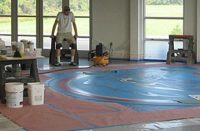
I knew there must have been a problem when my cell was ringing at 5:45 a.m., so I took the call. “Hey boss, it’s me. The ready-mix truck is here but there is a problem.”
My voice sank as I asked, “What’s the problem?”
My foreman answered with disgust: “There is no color in this load. What do you want to do?” With three words, I knew today’s profit was gone: “Send it back.”
There are so many situations in decorative work we have no control over that it’s not funny. In this case, I specifically remembered placing the order with concrete dispatch and including the color number and poundage. You know what I got when I called the dispatch that morning.
“That’s right, you wanted color in that load. I’m sure sorry about that, Doug. Send it back and we will add color to the load.”
Just what I needed — a hot load on a hotter day. No chance. Even though the concrete supplier apologized, I knew it was my fault. I got sloppy and didn’t confirm the mix design on a very important pour day. Another paid education with a lesson learned.
This column is all about stacking the deck in our favor. You have probably noticed there are few safety nets in this business, which validates the importance of doing everything possible to control the controllable. Ask any successful decorative contractor and I will bet there is at least one thing they all have in common: organization.
Below are a few decorative dangers and a few ways to avoid them. I realize there may be other ways to solve these issues, and some are surely better. But the goal here is to get the wheels turning. Space is limited, so I will cover the most common.
Danger No. 1: Lack of organization
How often do you or your crew arrive on a job only to realize there are items missing that are needed to complete the project? This is by far the most common danger to both beginners and pros. Nothing is more frustrating than having a crew stand and wait while you’re driving across town to pick up a sprayer or plastic. Before we throw around a few suggestions, let me say this — decorative concrete is the ultimate team sport. As with any team sport, success is determined by momentum, and momentum is lost when you are standing at the checkout line. What’s more, most local hardware stores do not carry stains, sealers, color hardeners, or other specialized tools needed for this type of work.
My suggestion is to get out ahead of your crew. This is best to do the afternoon before by making a checklist of all items and supplies needed. Have them warmed up and ready for the next morning. Many things on this list should be delegated (see Danger No. 3) to your foreman or another “go-to” guy. I have heard many contractors say this is hard because they don’t know what they need until they get to the job. My suggestion is to get to the job before you start it. Besides, most decorative projects require the same tools or front-end work.

I used to take this time to draw a sketch of the whole floor, showing decorative saw cuts, and pencil stain colors into the pattern chosen. This sketch would hang somewhere on the project so everyone knew what color went where. This eliminates some risk and spreads accountability to the whole crew. Mistakes in decorative concrete are back-breakers in most cases.
I realize that many contractors leave the project early enough in the day to bid new projects or take care of other job-related issues. Try requiring your lead man or foreman to call and brief you at the day’s end about job status and items needed for the next morning. My foreman and I do this every afternoon while he is driving back to the yard.
Try this if you are still working with your crew daily. Once or twice a day, maybe during breaks, walk your job, mapping a plan of action and job tasks for your crew. Most of us end up with our heads down, hip-deep in the trenches, when we should be planning the next move for our crew.
Remember, all important orders for items like stains, sealers, overlay materials, color hardeners, ready mix, and so on should be confirmed. My supplier will stock large amounts of common materials in my yard, inventory what’s used, and bill me accordingly. This works out great for him and I never run out of important supplies.
Danger No. 2: Lack of experience
This is damaging to not only the project attempted but the industry in a whole. Now new guys, listen — I can understand having problems years ago when decorative information was hard to find, but not anymore.
I have two suggestions. First, hire a consultant to come work the job with your crew. I realize this appears to cost quite a bit but I can assure you it is money in the bank. The reason I know this is because this is exactly what I did years ago when the staining market came to town in my area. I hired Wes Vollmer to come work a project with my crew and then handed him a check at the end of the project. There is no better classroom than the one on the job.
The second suggestion is to work a “deminar” with one of the decorative industry’s top guns. I hate to mention any names because there truly are a lot of great options. Stick with the ones who have proven their success. This will also be beneficial when it comes time to pick the right product for the job. Regardless of which method you decide, most instructors or consultants will continue to help answer questions long after your check clears.
Here’s one other note on this danger. Chris Sullivan offers a three-hour seminar every year at the World of Concrete conference on “troubleshooting” decorative concrete. Sign up early next year because this class will fill up. I caught up with Chris after one of his classes in Vegas and told him that I had the same problem as one of the projects he offered as an example that day. Imagine my embarrassment when he told me that that was my job, used by him to illustrate what not to do. This can be a humbling profession.
Danger No. 3: Lack of delegation
Why is it that decorative contractors think that no one can do it as well as they can? I realize it takes time to mentor and train someone to fill tasks to your expectations, but it is ridiculous to try to be everything to everyone. Delegation is the only way to grow and expand your company and still live an enjoyable life. There is little doubt that the key to delegation is picking the right person to trust, and sometimes this may not be your lead man. Every employee brings something different to the decorative table and it is important to utilize their talents. I truly believe the secret to picking the right person is finding someone that is willing to be held accountable. Be sure to be upfront in explaining the importance of the task being delegated. The task should be performed together at first, and then solo when the task is completely understood. Remember, if you don’t take the time to train someone else, you will be doing it yourself for the rest of your working life. Watch for things falling through the cracks and address them immediately but respectfully. Accountability is the best motivator in most cases.
Over the years I bet I have had dozens of surgeons for clients. We know that these guys are given some duties that cannot be delegated for obvious reasons, but I’ll bet that pre- and post-operation tasks are rarely performed by these doctors. I can also assure you that someone has some answering to do when instruments needed are not at hand.

Danger No. 4: Too much too fast
Rushing through a decorative project is like trying to fit a square peg into a round hole. Most of us find ourselves going too fast, myself included, for one reason: money. The problem with most of our bidding processes is that we usually don’t account for adversity. Few decorative projects run from start to finish without some form of adversity. It is for this reason that most decorative contractors run low-volume companies, myself included. At least once a month I find myself having to administer tailgate therapy, well, to me. These are the times I have to remember to put the job first and the budget second. I strongly believe that if our goal is quality decorative work, dollars will be the least of our problems.
Another problem with rushing a job is the number one enemy of this industry, moisture, whether the specific issue is failing to take a moisture test or not allowing a project to completely cure before sealing. Blushing, blistering, peeling, milkiness — you name it and it is most likely moisture-related. (See my tip at the end of this column.) This can be a challenge because most job superintendents have tight timetables and budgets to contend with. Trying to force these products to do what they are not designed for will only create big problems down the road. I strongly advise standing your ground on fast-track projects or at least demanding release-of-liability forms be signed before continuing. Invest in a slab moisture tester and use it on every job. This will also come in handy if fingers start pointing months down the road. Write down the moisture number and keep it with your job file or database. If you’re just breaking into the decorative business, try calling a flooring company and see what they would charge to swing by and test your floor.
To conclude, here’s a decorative tip: Add a few sentences into your decorative contract about the possibilities of adverse reactions to the sealer and how they can be beyond your control. Believe me, chemists for the sealer manufacturers are as busy as Santa’s elves trying to keep up with sealer compliances. Most of us do minor touch-up fixes, usually due to moisture, but this will take some of the pressure off if you find a situation that completely goes south. Remember, the goal is to fix the problem and keep your customer happy, not profit from an unfortunate situation.















